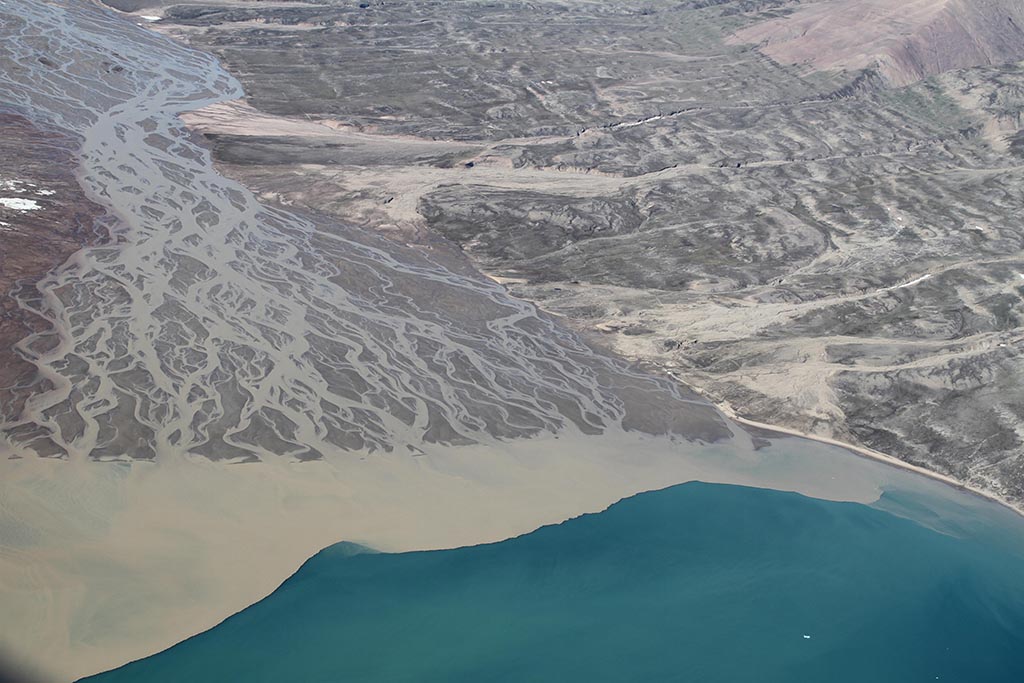After glacial rock flour is formed, glacial melting carries it to deltas like the one shown above. Photo by Minik Rosing.
The University of Copenhagen is studying glacial mud as a source of minerals for soil.
There is more than one way to remineralize the Earth, as Minik Rosing and his team of researchers at the University of Copenhagen are showing. They have recently embarked on a three-year project in Greenland to study glacial mud for use in remineralizing depleted soils. The key ingredient is “glacial rock flour,” which forms when Greenland’s glaciers shift, grinding rocks into powder as a mill grinds wheat into flour. With a recent grant of 5 million DKK (about 750,000 USD), the project has the potential to lead to many significant practical applications.
Most importantly, glacial rock flour can be used in food-poor nations to provide nutrition, much like the flour that makes our bread. Food security is a major issue in many tropical nations, with climate instability leading to poor growing conditions and catastrophic food shortages. The fact that tropical soils are often nutrient poor exacerbates the problem. The rich combination of minerals in glacial rock flour makes it a good candidate for use in the remineralization of depleted soils, especially tropical soils, which are often missing the exact minerals that rock flour can provide.
This can help the stability and overall output of crop growth in tropical regions, as well as help with reforestation efforts. As forests regrow and biomass increases, more carbon is sequestered. As long as shipping rock flour from Greenland to the tropics does not produce an excess of atmospheric carbon, this can also serve a way to reduce greenhouse gases and lessen the effects of climate change.
Finally, if remineralizations in the tropics catches on, glacial rock flour could turn into an important industry in the economy of Greenland. Again, this primarily relies on a reliable way to ship it across the oceans to where it is needed.
There is still more work to be done, and the project is ongoing, but the potential is reason for hope.
Benjamin T. Rancourt received his PhD in Philosophy from the University of Massachusetts Amherst in May 2016. His continuing philosophical research focuses on understanding, knowledge, and science, among other topics. This research ties into his wider goal of encouraging deeper understanding of ourselves, our strengths, and our limitations. He hopes that greater understanding will help us use the resources available to us to preserve what is good and address what is wrong. Walking is his primary mode of transportation. He appreciates the natural world. He lives in Northampton, Massachusetts with his wife Julia.
For more information:
“Greenland mud to ensure the world’s food supply” http://greenlandperspective.ku.dk/news/2016/greenland-mud-to-ensure-the-worlds-food-supply/“Stones to Bread” http://greenlandperspective.ku.dk/news/2016/oped/
“Andreas de Neergaard on Glacial Rock Dust” http://www.undergroundchannel.dk/andreas-de-neergaard-on-glacial-rock-dust
Project leader:
Prof. Minik Rosing of the Natural History Museum, University of Copenhagen.
Other contacts:
Rebekka Knudsen, Senior Consultant, Greenland Perspective, Nat Hist Mus, U Copenhagen
Martin Bertelsen, Communications Officer, Greenland Perspective, Nat Hist Mus, U Copenhagen
Peter Andreas, Greenland Perspective, Nat Hist Mus, U Copenhagen

